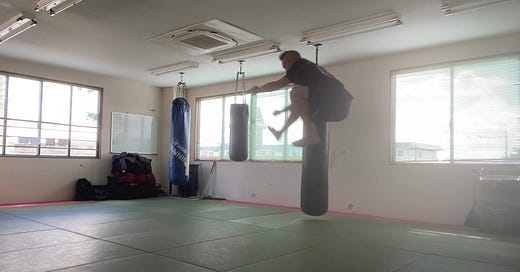“The kicking form.”
Coming from Tae Kwon Do originally (and not being happy in it), I loved that the footwork of Kajukenbo forms focused on using your legs to get you where you’re going so your hands could do the work, rather than throwing too many kicks. It felt much more realistic to me in this day and age.
But of course, kicking has its place, so it’s vital we practice them. Enter Pinan 8. Every Pinan starts with a front kick in the opening salute, but Pinan 8 has a kick or three (or at least a knee strike) on every count. That separates it from the rest.
I don’t remember much about my time learning this form, because it’s a quick one - it might be our shortest after Pinan 4, despite the techniques buried in it. The most unique of those is the “big jump” accompanying a front kick. I find the placement of the jump reminiscent of the jump found in a Karate form called “Unsu”, a form I’ve seen a few times in the Olympics. Unsu and Pinan 8 are pretty different, but the random placement of a high jump in an otherwise “walking” form makes you wonder why the instructors included them.
Did the original instructors want us to practice jump kicks against invading horsemen, or is it just an exercise to work your legs? Why is there only one jump in the whole form?
I also remember Sifu Martin Gomez (another black belt under Ron Esteller) sometimes using the first triple kick motion of Pinan 8 as a great warmup in class. It’s totally unrealistic for fighting, but working on the balance necessary to do the kicks correctly is an awesome way to strengthen your legs. I’ve stolen that warmup and used it a bunch of times for my classes.
It was also interesting to see the three “scrolls”. Before Kajukenbo I had heard them called “knife hand blocks”, and I only saw two of them used. Scroll 3 is a fun one when you’re doing a form and want to swing hard. Pinan 8 was my introduction to it.
The constant kicking of the form also brings one more story to mind. A few years ago I saw a random video on the internet of two Tae Kwon Do practitioners doing a form that involved nothing but sparring-style kicks. It looked more like shadow boxing with TKD techniques, except two people did it side-by-side to show that they weren’t just making it up on the spot. The rhythm was constant, and it mimicked the TKD rhythm and bouncing of sparring.
Having no low stances, and looking nothing like a traditional form, the two competitors got last place in the forms competition. They went on to get first place in the sparring.
Forms are supposed to inform your fighting, right? Great Grandmaster Juarez loves to make students work the forms slow and strong before making everyone drill them at full-fighting speed. Pinan 8 becomes a great workout when you do that.
What are your stories and thoughts on our eighth form?












Share this post